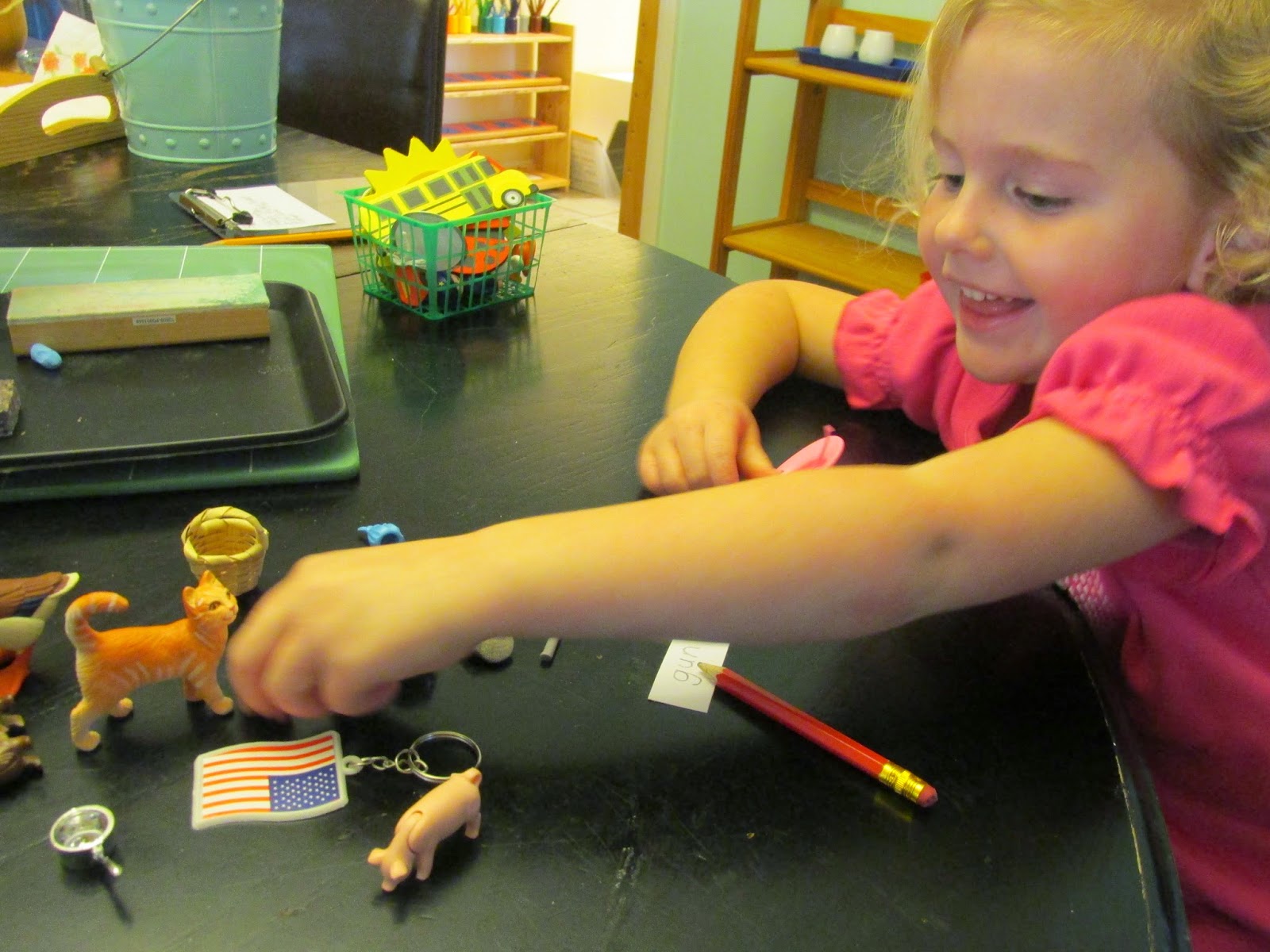 |
| Wow, this post got way too long. Please admire Alleluia's birthday cake--YUM! |
- you often wonder if you are on the right track with your Montessori kid
- you feel overwhelmed by all of the separate works you need to learn about and don't know what comes next
- you like chocolate (oh, sorry! how did that get in there....)
- you secretly wish you had a stack of tacky worksheets to prove that your child is learning
Children schooled in the traditional way and children taught using the Montessori method all end up at the same destination--literacy, ability to work with numbers--but their paths are VERY different.
 |
| The iconic "Farm," with which you can teach parts of speech, but which most of us secretly want to play with. |
Language
The Montessori child has been steeped in Language works and games since 2 1/2 (or even before!). By 5, there has already been a huge amount of work, including (brace yourself):- I Spy Game ad nauseum
- Enrichment of Vocabulary (Name Game, 3-part cards, give language with Sensorial lessons, etc)
- Stories, Rhymes, Self-Expression, I Wonder....
- Preparation to Write (usually around 4 1/2, if the child's hands and mind are ready)
- Sandpaper Letters (including digraphs like 'sh' and 'ch')
- Moveable Alphabet (3)
- Metal Inset (3-5)
- Writing with Chalk (4-5 1/2)
- Phonetic Object Game (4-5)
- Phonetic Reading Cards (4-5)
- Phonograms (4 1/2 - 5)
- Sight Words (4 1/2 - 5)
- Reading Classification (4 1/2 - 5)
- Parts of Speech (4 1/2 up)
 |
| Language: Parts of Speech boxes along the left... |
Your little whippersnapper is working on three aspects simultaneously: phonics, sight words (words that aren't spelled phonetically), and phonograms (2-3 letters that can't be sounded out). If things have been going pretty well, Junior might be writing simple words phonetically now, starting with short vowel consonant-vowel-consonant words like hot, cat, sis, etc. "Writing" means using the Moveable Alphabet.
Huh? Isn't that cheating?
Many 4-year-olds don't have good control of the pencil yet, even if they do have a good pencil grip. Finger strength is another issue. While the Metal Insets and other works focus on good pencil control, using the Moveable Alphabet helps to isolate the child's ability to spell phonetically.
 |
| The classic use of the Moveable Alphabet is to make up stories. An adult can copy them down in the child's journal afterward, and the child may even like to illustrate. |
Function of Words/Parts of Speech
Learning about the function of words (noun, article, adjective, verb, etc) is introduced at 4 1/2. If you don't have the materials for these works, they are super easy and cheap to make. (Readers, please let me know if you'd like more info on that.) Also, you don't necessarily teach your child terms like "Article" during the lesson (only in naming the lesson), but if he or she happens to remember that term, imagine all of the super fun games of MadLibs you can play!
 |
| Those colored triangles are Grammar Symbols. |
A Note on Sounds:
With the Sandpaper Letters and Sandpaper Digraphs the children learn 40 basic sounds (26 letters in the alphabet plus 14 double letter sounds, like 'th'). When you begin to teach the Phonograms (which include the 14 digraphs), the number of non-phonetic sounds goes up to about 25. I am being vague because I only kinda sorta get it myself..........
Moving Right Along.......
At 5, you're just building on the foundations. Your child identifies verbs (action words), learns syntax (what sounds correct and what just sounds strange), and basically becomes a total Grammar Ninja.
Math
If the child has been progressing well in Language before his or her 5th birthday, you may have already introduced:
- Number Rods (once the child is well advanced in Language and is beginning to read and write)
- Sandpaper Numbers (same as above)
- Number Rods and Cards (4-5)
- Spindle Boxes (4-5)
- Cards and Counters (4-5)
- Memory Game of Numbers (4-5)
If you introduce Math before your child has a good start on Language, you are ignoring what we know about the sensitive periods. Alleluia seemed to be doing fine with Language, so she had done these basics.
 |
| Chalkboard numbers aren't listed in my album, so I just squished them in along with Sandpaper Numbers. (Too bad you can't see the extremely cute baby I'm holding on my lap!) |
If things seem to be purring along well, then these can also be introduced:
- Decimal System: Presentation with Beads (4-5)
- Decimal System: Presentation with Cards (4-5)
- Teens and Tens: 11 - 19 Beads Only (4)
- Teens and Tens: The Teen Boards (4-5)
- Teens and Tens: 11 - 19 Teen Boards and Beads (4-5)
- Teens and Tens: 11 - 99 Ten Boards with Beads (4-5)
- Linear Counting: 100 and 1000 Chains (up to 5 1/2)
- Teens and Tens: Skip Counting--Number Chains with Squares and Cubes (up to 5 1/2)
- The Formation of Complex Numbers with Beads and Cards (4 1/2 - 5)
 |
| Teen Beads |
 |
| The Decimal System: Introduction to the Bead Material |
 |
| Forming Numbers with Beads and Cards |
 |
| Skip Counting with Number Chains |
Anyhoo, ...
You get the picture. This is what a normal progression for a brand-spanking-new 5-year-old might look like. The only sense in which specific timing matters is knowing the sensitive period that your child is in (Language comes before Math) and knowing the progression of works (which comes first, then which comes after, etc.).
I hope this post was helpful! Please correct my mistakes, make silly comments or share ideas for 6-year-old birthday cakes with me!





No comments:
Post a Comment